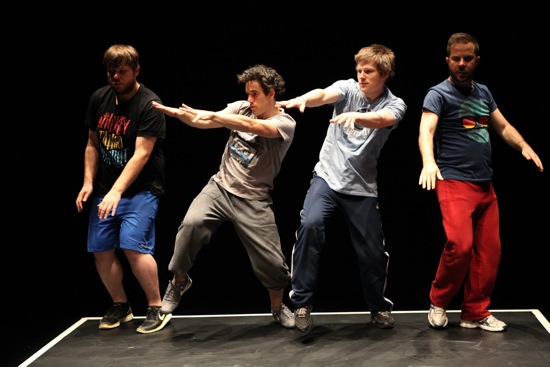
Michael Dunbar, Ross McCormack, Alisdair Macindoe, and Jake Shackleton in Lucy Guerin’s Untrained. Photo: Julieta Cervantes
The Brooklyn Academy of Music’s Fisher Space in its compact new building is proving to be dazzlingly adaptable. The seating has been configured differently for all four works that I’ve seen there as part of BAM’s 30th Next Wave Festival, and that design, in turn, influences scenic possibilities and alters the audience’s angle of vision and relationship with the performers. Lucy Guerin’s Untrained was designed for a more traditional set-up, so at the Fisher, we sat in twelve long, banked rows at one end of the space, which limited the performers to a shallower area than that occupied earlier in the season by either Jonah Bokaer’s Eclipse or Nora Chipaumire’s Miriam. Miguel Gutierrez’s And lose the name of action, which followed Untrained into the Fisher a week later, seated the audience in three banks of two or three rows each, which were arranged in an irregular, gapped triangle. The performers occasionally ventured so close to the spectators that crossing your legs was inadvisable.
Most of us weren’t sitting within spitting distance of the performers in Untrained, but over the hour that the piece lasted, we came to know them very well. These are their names: Michael Dunbar, Alisdair Macindoe, Ross McCormack, and Jake Shackleton. Macindoe and McCormack are experienced dancers; Dunbar is a freelance interaction designer; Shackelton is an environmental engineer with conservatory training as a pianist.
I remember that once, during my dancing days, a colleague said, “We’re not people, we’re dancers.” I don’t recall the occasion—maybe it had to with the resourcefulness with which she was turning a train seat into a campsite—but the words stuck with me. They sprang into life when I was watching Untrained. Uncompromisingly and affectionately, Guerin has created a structure that rings changes on three related points: dancers are clearly people, but they have physical skills and a knowledge of the body that many non-dancers don’t; people with no dance training approach movement in ways that dancers may find it difficult to imitate; you can’t always tell a dancer from a non-dancer.
The set-up is simple. A large gray square is marked off in the center of the performing space. It’s flanked by smaller white squares, edged with sheets of paper. Four bottles of water stand by. Untrained is, structurally speaking, a vaudeville—well over twenty “acts,” some of them under a minute long. These involve speaking, singing, drawing, and film appearances, as well as dancing. Often the performers line up on one side of the space or another—covertly checking what’s written on the papers—and walk into the center one by one. At other times, they step out of an assembled group at the back of the main square to perform individually or as a twosome.
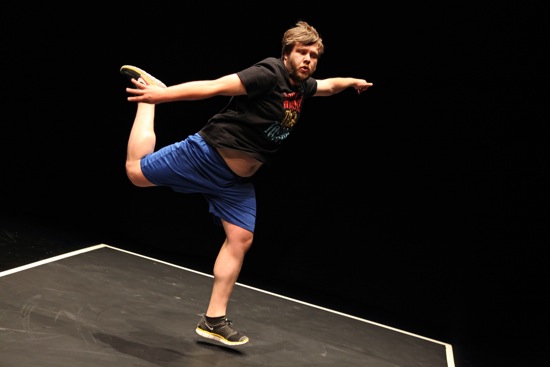
Michael Dunbar shows his stuff in Untrained. Photo: Julieta Cervantes
Guerin rehearses a given cast for this tidily structured improvisation for only five days, lest the performers become too secure in the tasks and too aware of the audience. She also changes the cast for the same reason. The professional dancers pull no punches; barrel turns, pushups, balletic jumps are essayed across the area (better to call it an arena). For Macindoe and McCormack, it’s a no-brainer to grab one foot and hoist a leg high to the side; Dunbar and Schackleton gamely indicate the move, having difficulty even standing on one leg (the spectators laugh, but not unkindly). The two dancers have a sophisticated understanding of how their bodies negotiate the space around them and the most advantageous timing. But get the four to create agonized falls or act out iconic speeches from films, and they’re all wonderful (or terrible) in their own individual ways.
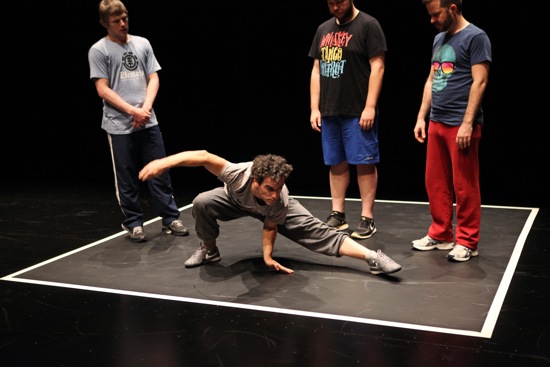
(L to R) Macindoe, Dunbar, and Shackleton watch McCormack. Photo: Julieta Cervantes
Dunbar and Shackleton have very different bodies and ways of moving. Dunbar is a large man and moves with a looseness that’s almost floppy. Shackleton is tauter and trimmer, rhythmically astute; his range of motion is smaller and more precise. This isn’t to say that Macindoe and McCormack aren’t different from each other in appearance and qualities, but training masks those differences when certain skills are called for. In some sequences, the four are more or less equals—singing the opening of Beethoven’s Fifth as different instrumental voices, while Shackleton conducts, for instance. They all roll on the floor in the same way.
Guerin makes us look carefully. She opens our eyes to subtleties of similarity and difference, while offering us a work that’s elegantly developed and deliciously entertaining. When McCormack performs a mini-solo, Shackleton describes it for us. Then Dunbar performs and Macindoe finds words to explain it (how they see is as interesting as what they do.) McCormack gives Dunbar detailed instructions—like “make a robot”—for a solo dance, and Dunbar gives it his best shot. When Dunbar takes off in a wild solo, and Macindoe has to copy him as he goes, the highly skilled dancer has trouble picking up his colleague’s free-flowing, floundering extravagances (it seems easier for McCormack to imitate Shackleton, since the latter tends to be precise and reined-in).
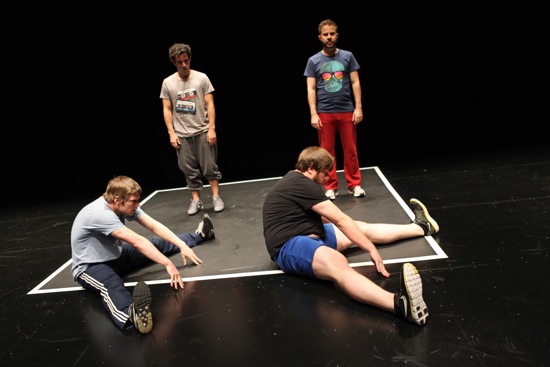
Macindoe (L) copies Dunbar. McCormack (L) and Shackleton watch. Photo: Julieta Cervantes
We can relish the different ways in which, one by one, the guys remove their tee shirts (McCormack’s method is a silky virtuosic act with no fumbles.) They may not be equal in physical skills and theatrical timing, but they all go for broke in depicting a cat accidentally electrocuting itself. Guerin’s work offers insights not just into how dancers differ from non-dancers in terms of physical acuity, but how individuals differ from one another. The short films that the men have created to star themselves are revealing, as are their recollections of their fathers, or their telling us their secret afflictions and fears.
When the four make observations about Untrained and the process of putting it together, McCormack notes the honesty of the untrained men in performance, while Dunbar says that he and Shackleton think and then do, while the trained ones just do; “thought becomes action.”
In the end, Guerin’s essentially uncomplicated idea is not so simple after all.
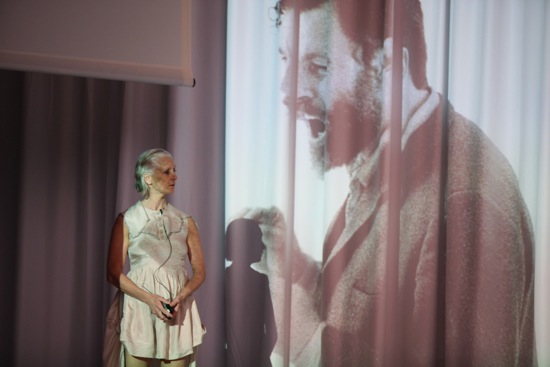
K.J. Holmes with Paul Duncan onscreen in Miguel Gutierrez’s And lose the name of action. Photo: Julieta Cervantes
Gutierrez’s And lose the name of action is anything but uncomplicated. Ideas and images swirl around. Lights (I’ve never seen as many as Lenore Doxsee’s design calls for) turn gold, green, violet, glaring white. An immense, filmy, white object is suspended overhead like an upside-down white parachute. A sheer white curtain veils the only open wall of the Fisher. Two large screens hang opposite each other, and periodically the bearded British actor Paul Duncan (excellent) appears on one or both as a black-and-white filmed image in a white limbo; he lectures us as if we were his students, his text drawn from Dr. Jeannette Norden’s lectures on neuroscience. Six performers dance, talk, sing, yell, laugh, and change clothes. They also, periodically sit among us in white chairs placed between our dark ones.
The piece’s title is the last line of Hamlet’s famous “To be, or not to be” soliloquy, in which he inquires into his own inaction. “Who would fardels bear,” he asks,“To grunt and sweat under a weary life,/ But that the dread of something after death,/ The undiscovered country, from whose bourn/ No traveller returns, puzzles the will.” It’s that something after death that interests Gutierrez and has fueled his ambitious and perplexing new piece. And lose the name of action is haunted by ghosts and other paranormal phenomena, presences sensed but not seen, and footsteps in the corridor, but Gutierrez also ventures into the intertwined nature of existence and perception, as well as the neurological disturbances that can disorder both of these. Much deep thinking has gone into And lose the name of action. and possibly Gutierrez intended to disorder the audience’s perception—risking confusion, disapproval, and worse. I can make more sense of the work now than when I was watching it, but that’s an odd way to experience art.
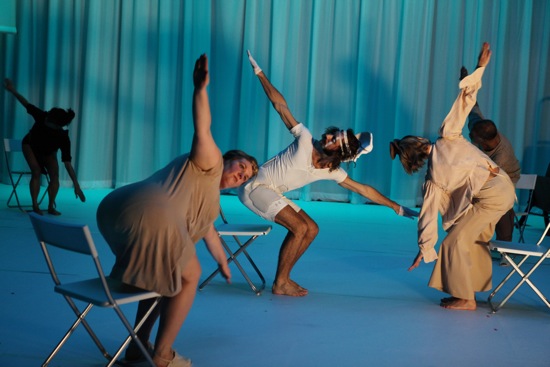
(L to R): K.J. Holmes, Hilary Clark, Luke George, Michelle Boulé, and Miguel Gutierrez. Photo: Julieta Cervantes
The very opening is rife with enigmas. Neal Medlyn’s unearthly score begins with a soft jangling and a distant male voice. A slim, gray-haired woman (K.J. Holmes), wearing a crown of sorts, lifts the lid of a white box; a light beams out of it onto her face as she peers in; she reads aloud, “I am an old man.” In the beginning, Boru O’Brian’s costumes are like shabby ghosts of regal attire. A collar, a cloak, a crown. It’s not only Hamlet’s ghost that’s indirectly evoked over the course of 90 minutes; it’s the specter of Hamlet the play.
Ishmael Houston-Jones puts on a smarmy voice to conduct a séance of the kind that intrigued 19th-century gatherings, but he mixes the appropriate commands with more contemporary ones, like “breathe” and “feel your feet on the ground” that invoke a different kind of mind-body experience. As if we’re sitting around a table in a medium’s parlor, we’re ordered to hold hands with our neighbors and wait for something to happen. “Are you there?” he calls out to a spirit. I see-hear-feel none, but oh, the light display and Houston-Jones with his arms raised! The others hopefully copy his gestures, while we hear the thud of footsteps.
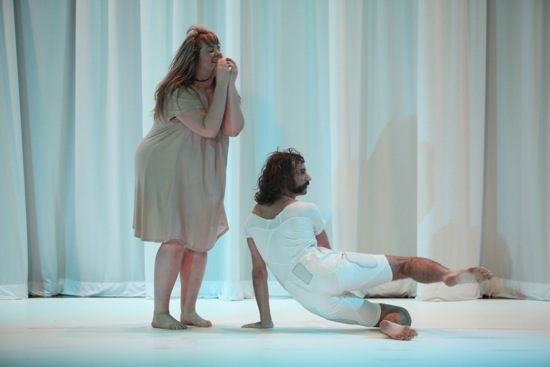
Hilary Clark and Luke George in And lose the name of action. Photo: Julieta Cervantes
It’s difficult to convey the many elements that appear out of nowhere and seem to lock into place. Is this the jigsaw piece that will complete the lake? No. Sure? Not really. Holmes and Luke George—a white stripe down his face, half his lower lip blue—consult a lot over the box. Hilary Clark has some extraordinary fits of dancing, her voluptuous body tossed by emotional storms or possessed by visions that appear to terrify her. At one point Holmes appears naked under a transparent tent of a costume and joins a bizarre family portrait, with Houston-Jones seated as if on a throne, while George and the wonderful Michelle Boulé continue to dance vigorously.
Some of the choreography is related to an initial solo by Houston-Jones. He’s not a young guy anymore, and he brings an engrossing mix of power and precariousness to the way in which he stamps around, raises one leg, pauses, strides, lifts a leg again, twists. But dancing, while integral to And lose the name of action, isn’t the most memorable part of it. I remember better Clark standing close enough to me to be touched and shuddering violently, or Houston-Jones lying naked at my feet, as stiff as a corpse. Gutierrez walks slowly along, bending forward and gradually regurgitating an 8-inch white substance that looks like frozen foam. Later, he kneels to bury his head in Holmes’s belly and then retreats, pulling a white length of fabric between his teeth until it comes loose from her (only now do I think about the umbellical cord that once connected Hamlet with his mother the queen).
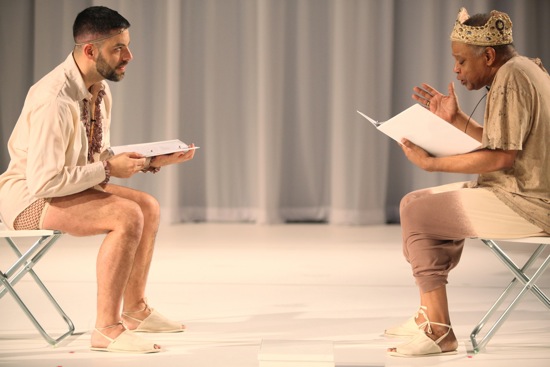
Gutierrez and Houston-Jones talk Berkeley. Photo: Julieta Cervantes
I recall the performers lying in a head-to-feet chain and twisting or rolling in response to Gutierrez’s verbal intstructions (and maybe to Duncan’s onscreen mention of a sea captain and the commands he gives to the sea). But I also think back to how nicely they chanted in harmony. And grow a little irritable remembering Houston-Jones and Gutierrez, facing each other on chairs and reading argumentatively about existence from philosopher George Berkeley’s Three Dialogues Between Hylas and Philonous. And re-experience a certain nervous pleasure induced by a sequence in which the performers rush about placing chairs and taking away those that others have placed until the activity seethes into pointless havoc. Close your eyes and think poltergeists.
In the end, the onscreen “professor” loses his poise and his certainty. Over and over, a phrase in Medlyn’s score repeats its seven-note run upward, its pause, and its drop onto a single lower note. Duncan thinks, struggles to get a sentence out, searches for the right word. Gives up.
A voice says, “thank you.” The performers take no bows. I take a last look around this elaborately peculiar world that materialized in the Fisher, and walk out bemused, thinking, “What the hell was that all about?” Now I’m contending with its ghost.
